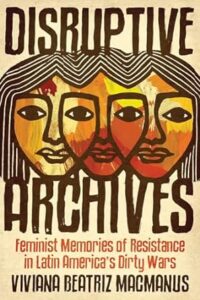Book Review – DISRUPTIVE ARCHIVES by Viviana Beatriz MacManus
how to join
Resources
about ccwh
We help women historians thrive through events, resources, and community.
Viviana Beatriz MacManus, Disruptive Archives: Feminist Memories of Resistance in Latin America’s Dirty Wars. University of Illinois Press, 2020. 196 pp. Dissident Feminisms Series. ISBN: 978-0-252-04353-6 (cloth). 978-0-252-08543-7 (paper).
Reviewed by Emily Sohmer Tai, Professor of History, Queensborough Community College, City University of New York
 While “archives,” a keyword in the title of this compelling book, evokes dusty records of a distant past, the Latin American “Dirty Wars,”—which claimed the lives of nearly 30,000 victims between the 1960s and 1980s in Argentina alone—have also left behind survivors whose memories of torture and loss constitute a living archive of oral witness. Witnesses who are women, MacManus argues, carry particular potential to disrupt what she terms “masculinist” narratives of struggle or reconciliation that have obscured the full historical record of these campaigns in two Latin American polities on which she focuses as case studies: Mexico and Argentina.
While “archives,” a keyword in the title of this compelling book, evokes dusty records of a distant past, the Latin American “Dirty Wars,”—which claimed the lives of nearly 30,000 victims between the 1960s and 1980s in Argentina alone—have also left behind survivors whose memories of torture and loss constitute a living archive of oral witness. Witnesses who are women, MacManus argues, carry particular potential to disrupt what she terms “masculinist” narratives of struggle or reconciliation that have obscured the full historical record of these campaigns in two Latin American polities on which she focuses as case studies: Mexico and Argentina.
The backbone of Disruptive Archives is a series of interviews MacManus conducted with twelve female activists from these two countries. In four chapters, flanked by an introduction and an epilogue, MacManus weaves their oral histories with published government records, documentaries, and fictionalized literary and cinematic narratives to argue that women do not merely tell a different story but tell a story differently—emphasizing female agency “to illuminate the parallel forms of gendered state violence that undergirded the nascent neoliberal modernist projects of Argentina and Mexico” (3). Integrating their testimonies into the historical narrative, contends MacManus, fashions memory into an instrument for achieving what the human rights scholar Wendy Brown has called “comprehensive justice” (4).
MacManus’s introduction is a survey of campaigns against activists inspired by the success of the 1959 Cuban Revolution to resist neoliberal capitalism in both countries. While Mexico’s history has received less attention, MacManus shows that here, too, there was repression. Her examples include the Tlatelolco Massacre on October 2, 1968, when paramilitary forces entered Mexico City’s Plaza de las Tres Culturas and opened fire on 3,000 peaceful protestors; the Corpus Christi massacre of student protestors in 1971; and the murders and disappearances of various known or suspected guerrilla activists.
MacManus compares the experiences of Mexican female activists to those of women in Argentina’s more notorious campaign against progressives under the leadership of Jorge Rafael Videla, who took power in a military coup in 1976 and retained it until 1983. “Although the state castigated the ‘deviant’ bodies of both leftist men and women,” writes MacManus, “it was the politically resistant bodies of women” –who joined socialist groups in large numbers—“that provoked anxiety and fear among the capitalist-patriarchal heads of state” (10). For MacManus, the memories these women share challenge the “Two Devils theory” that has posited the violence of the Dirty War period as the equal responsibility of “terrorists” from the left and repressive policing on the right, as well as representations of these women as merely passive victims (12).
Chapter 1 studies discrepancies between the witness of McManus’s subjects and representations of women in the records of Argentina’s National Commission on the Disappeared (CONADEP), published as the Nunca Más (Never Again) Report and Mexico’s Office of the Special Prosecutor for Social and Political Movements of the Past (FEMOSPP); Elana Poniatowska’s collection of oral histories from witnesses of the Tlatelolco Massacre; Nil el flacon perdón de Dios, an oral history of the Argentinian Dirty Wars; and Nora Strejilevich’s A Single Numberless Death. Chapter 2 interprets representations of women and gender in two fictional dramatizations of the Dirty War era, Marco Bechis’s Garage Olimpo and José Revueltas’s novel El apando (The Hole), through the lens of Achille Mbembé’s concept of “necropolitics:” “the subjugation of life to the power of death” (63). Chapter 3 shows how women’s memory may complement documentaries such as Flor en Otomí, a biography of the murdered Mexican activist Dení Prieto Stock, and Marta Diana’s Mujeres guerrilleras, an anthology of testimony from women who fought in Argentina. In chapter 4 and the epilogue, MacManus turns to her twelve interview subjects, arguing that their feminist oral histories continue to disrupt dominant narratives, as evidenced by the assassination of Argentinian torture survivor Silvia Suppo after testifying before a human rights commission as recently as 2010 and young female factory workers facing escalating femicide in Mexico. An appendix with transcripts of MacManus’s interviews might have been the only improvement made to this powerful book.
February 2, 2024
how to join
Resources
about ccwh
We help women historians thrive through events, resources, and community.
Copyright © 2022 Coordinating Council for Women in History. All Rights Reserved.
Privacy Policy | Terms of Use | site credit